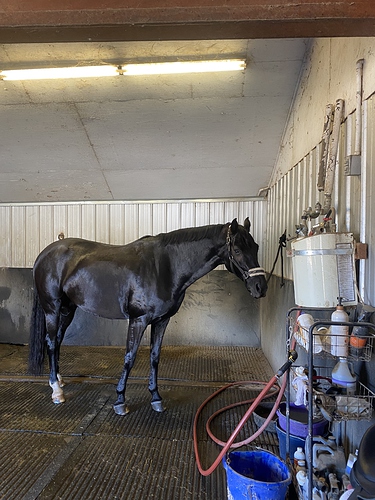Thanks!! The vaquero trainer had a hard time with them, too, but he is 6’1" and rides problem horses for a living. His timing is 1000x better than mine!! I’ve been working with this trainer here and there for about a year and she’s not comfy really coming down on him yet. He has a history and I can’t blame her.
No, she thinks strengthening the hind end, easy leg yields in both directions in the canter, isolating the front end and the hind end will help and we’ve been doing that. One issue I have is my horse anticipating so much. “oh, up centerline? we must be leg yielding in this direction” and he just does it when I don’t ask for it. I shake things up all the time re: movements and he seems to get perplexed and frustrated when he’s not “right” and I correct him. I can harshly correct him when he’s blowing through the aids and he’ll listed for a time or two. But then he’ll try super-hard to do again what he just did if I ask for something else. He’s not a great listener but is a great participant. Does that make sense?
He’s only 16.2 and is a light warmblood. Full sib to DSF Farscape.
We always start the canter work with a medium down the long side and when he anticipates that, I do collected work on the long side and mediums on the short side or circle or diagonal. Places he doesn’t expect it.
I’ll try your suggestion of really bending, asking for forward, changing and then really bending. My trainer is really having me work on bend and I’m really doing that work.
Yes, some others have mentioned somewhere that establishing the CC too much can prevent a horse from learning changes. I tried changes before his CC was well established. Fail. I used CC much to balance his canter in hopes of training changes. I don’t ride CC much anymore but he sure remembers it.
Of note, I was able to get clean changes when he was younger, very hot, and when I was desensitizing him by riding at QH shows. If he picked up the wrong lead, he was mentally “up” (read: hot) enough to do the flying change when the judge wasn’t looking. He wasn’t really thinking, he was just reacting. I think he’s overthinking much now and I honestly think he’s being honest most of the time. That said, he’s also lazy. He’s a very quirky horse.
i appreciate your explanations!!
 (I’ll move her up once the changes are completely seamless, someday I hope). Behold her big canter booty:
(I’ll move her up once the changes are completely seamless, someday I hope). Behold her big canter booty:

